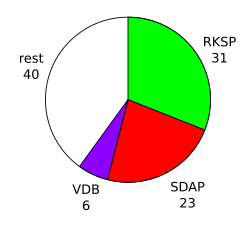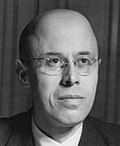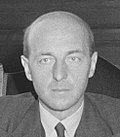Schermerhorn–Drees cabinet
Schermerhorn–Drees cabinet | |
|---|---|
41st Cabinet of the Netherlands | |
  Presentation of the incoming cabinet at the Binnenhof on 4 June 1946 | |
| Date formed | 25 June 1945 |
| Date dissolved | 3 July 1946 1 year, 8 days in office (Demissionary from 16 May 1946) |
| People and organisations | |
| Monarch | Queen Wilhelmina |
| Prime Minister | Willem Schermerhorn |
| Deputy Prime Minister | Willem Drees |
| No. of ministers | 16 |
| Member party | 25 June 1945 – 9 February 1946 Roman Catholic State Party (RKSP) Social Democratic Workers' Party (SDAP) Free-thinking Democratic League (VDB) 9 February 1946 – 3 July 1946 |
| History | |
| Legislature term(s) | 1937–1946 |
| Incoming formation | 1945 formation |
| Outgoing formation | 1946 formation |
| Predecessor | Third Gerbrandy cabinet |
| Successor | First Beel cabinet |
| Part of the Politics series |
![Azure, billetty Or a lion with a coronet Or armed and langued Gules holding in his dexter paw a sword Argent hilted Or and in the sinister paw seven arrows Argent pointed and bound together Or. [The seven arrows stand for the seven provinces of the Union of Utrecht.] The shield is crowned with the (Dutch) royal crown and supported by two lions Or armed and langued gules. They stand on a scroll Azure with the text (Or) "Je Maintiendrai" (French for "I will maintain".)](http://upload.wikimedia.org/wikipedia/commons/thumb/8/8f/State_coat_of_arms_of_the_Netherlands.svg/150px-State_coat_of_arms_of_the_Netherlands.svg.png) |
|---|
|
|
The Schermerhorn–Drees cabinet was the
This, the first
The cabinet served during the early days of the post-World War II 1940s. Domestically, it initiated recovery and rebuilding, and implemented several major reforms to
The Schermerhorn–Drees cabinet consisted of ministers from the SDAP (which in 1946 merged with the VDB and the CDU to become the post-War PvdA or Labour Party), the CHU minister Dr. Piet Lieftinck (who became a member of the PvdA on 9 February 1946), the ARP and the RKSP (named the KVP on 22 December 1945). Prime Minister Willem Schermerhorn was a member of the VDB, but would later become a member of the PvdA. Deputy Prime Minister Willem Drees was a member of the SDAP.
Cabinet actions
One of the main tasks of the cabinet was to revive the Dutch
Until August 1945 the war against Japan in the Dutch East Indies was also a main objective of the cabinet. After the Japanese surrender the cabinet was faced with the Indonesian nationalists Sukarno and Hatta, who proclaimed the independence of their country.
Another objective of the cabinet was the purification of the black money circuit. During the period the bank accounts in the Netherlands were under investigation by the Ministry of Finance, every Dutch citizen was given 10 guilders by the cabinet, in the Netherlands known as 'Het tientje van Lieftinck' (Lieftinck's tenner), named after the minister of Finance, Dr. Lieftinck.
Cabinet members
- Retained from the previous cabinet
- Continued in the next cabinet
- Appointed as Minister without portfolio for Foreign Affairs
- Appointed as Minister of Foreign Affairs
Trivia
- Four cabinet members had previous experience as scholars or professors: Willem Schermerhorn (Hydraulic Engineering and Surveying), Louis Beel (Administrative Law), Piet Lieftinck (Financial and Business Economics), Gerard van der Leeuw (History of Religion and Egyptian Language and Hieroglyphs).
References
- ^ Changing Liaisons The Dynamics of Social Partnership in 20th Century West-European DemocraciesBy Karel Davids, 2007, P.165
- ^ Changing Liaisons The Dynamics of Social Partnership in 20th Century West-European DemocraciesBy Karel Davids, 2007, P.165
- ^ "Coalities tussen sociaaldemocraten en confessionelen" (in Dutch). Historisch Nieuwsblad. 10 August 2006. Retrieved 24 April 2018.
- ISBN 90-232-1412-9.
External links
- Official
- (in Dutch) Kabinet-Schermerhorn/Drees Parlement & Politiek
- (in Dutch) Kabinet-Schermerhorn-Drees Rijksoverheid















